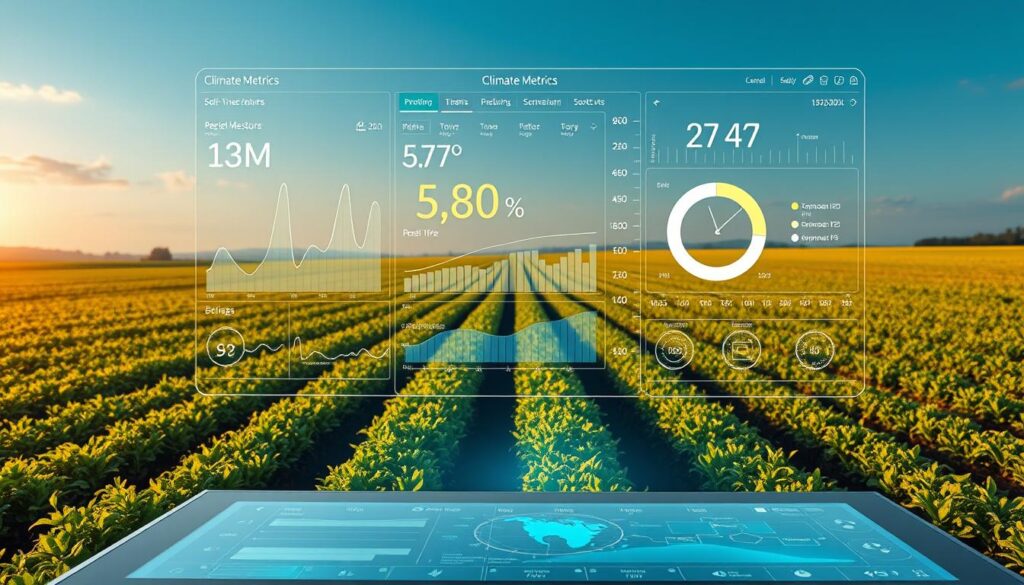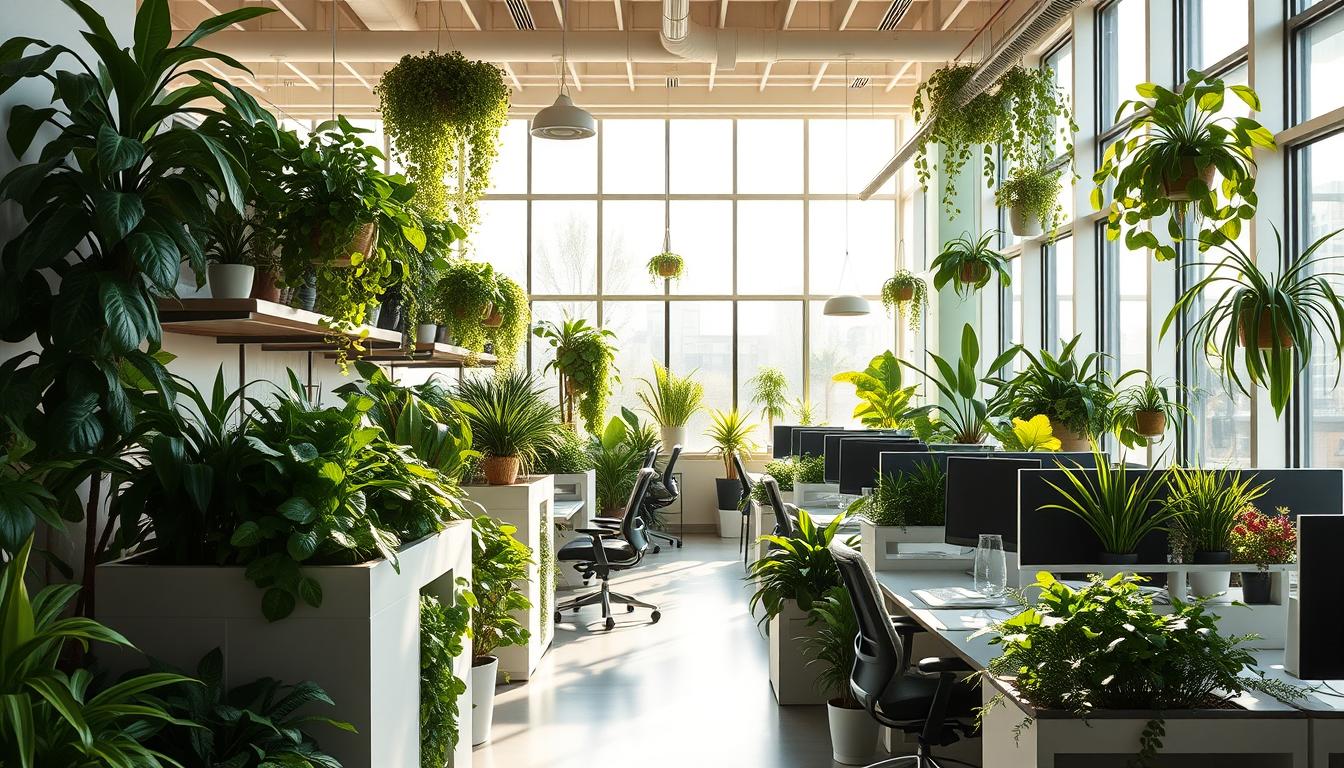Today, modern farming is all about precision. It’s crucial to know the climate right now, not just in general. Thanks to tech, farmers can watch how plants grow and see what the weather is doing. This smart way of farming helps grow more food and tackles big issues like hunger.
As farming gets advanced, keeping an eye on the climate through plants is key. It brings new ways to check on our environment and use resources wisely. We’re stepping up our farming game, making sure we feed more people without harming our planet.
Understanding Climate Metrics in Agriculture
In agriculture, managing crops well depends on watching the environment closely. Understanding climate metrics is key for better farming and more crops. Farmers need to keep an eye on temperature, humidity, and soil wetness to adjust quickly to new conditions.
The Importance of Monitoring Environmental Factors
Monitoring the environment helps farmers make choices that boost their output. Important factors include:
- Temperature changes that affect how plants grow
- Humidity and its impact on water loss from plants
- Soil moisture, which is vital for roots
Watching these factors closely helps farmers make timely changes. This can lead to more and better-quality crops.
How Climate Variability Affects Crop Yields
Changes in the weather pose a big challenge to keeping farming going strong. Weather ups and downs can harm crop amounts. Having up-to-the-minute climate info helps farmers reduce problems from:
- Sudden hot or cold spells
- Unplanned dry periods or too much rain
- Shifts in bugs and diseases
By using data wisely, farmers can improve how they farm. This helps them deal with the unpredictable nature of today’s agriculture.

Real-Time Climate Metrics via Plant Presence
Real-time climate metrics are crucial for modern farming. They give farmers up-to-the-minute info on the environment’s impact on crops. By collecting and analyzing data, farmers can promptly adjust. This improves crop growth and optimizes conditions.
Defining Real-Time Climate Metrics
Real-time climate metrics continuously monitor environmental factors affecting plants. They use advanced techniques to gather data, including:
- Soil moisture levels
- Air humidity
- Temperature fluctuations
- Light intensity
Farmers use these metrics daily to quickly meet crop needs. This boosts the health and yield of the crops.
Utilizing Plant Presence for Enhanced Monitoring
Insights into plant presence help understand crop conditions better. Advanced sensors measure things like chlorophyll fluorescence. This shows how well photosynthesis is happening. With this info, farmers can:
- Spot stress conditions early
- Change irrigation practices
- Tweak nutrient use
Automated systems offer instant feedback. This lets farmers quickly change the environment based on plant responses.
Automated Climate Control Systems
Automated climate control systems are changing how we manage greenhouses. These systems bring precision and efficiency to creating the perfect environment for plants. With smart sensors, growers monitor and adjust conditions easily, making sure everything runs smoothly without always having to be there.
How Automation Optimizes Growing Conditions
Automation is key to better growing conditions. With it, greenhouse managers can ensure:
- Consistent temperature regulation
- Exact humidity levels
- Real-time adjustments based on environmental data
This boosts crop quality and cuts down on wasted resources. Growers can increase their output and be more sustainable thanks to precise control.
The Role of Smart Sensors in Management
Smart sensors are vital to automated climate control systems. They track important things like temperature, humidity, and light. Here’s why they’re great:
- They keep an accurate eye on the environment
- They instantly react to changes
- They lower the chance of human mistakes
With smart sensors, greenhouse workers can make important decisions while tech handles the day-to-day stuff. This leads to better management and healthier plants.
AI and Machine Learning Enhancements
AI is changing farming by improving climate predictions. With machine learning, farmers can look at lots of data to make good forecasts. This helps them plan better and make smart choices in their fields.
Utilizing AI for Climate Predictions
Farmers use artificial intelligence to better understand weather and the environment. Predictive models, made from past data, let them act before climate problems hit. This keeps their crops and income safe from bad weather.
Data-Driven Decision Making for Sustainable Practices
Machine learning helps farmers make choices that are good for the earth. They check how well they’re doing by looking at data in real time. They can change how they farm to use less and waste less. This makes farming better for the planet.
The Impact of Algorithms on Resource Efficiency
Algorithms help farmers use resources like water and fertilizer more wisely. AI insights lead to using less but getting more. This boosts how much food they grow and cuts down on harm to the earth.
Integration of IoT Devices for Seamless Monitoring
Integrating IoT devices into farming has greatly improved how we look after crops and conditions. These devices connect environments. They make it easier to keep an eye on key factors for healthy crops. With data from sensors, farmers manage their resources better.
The Potential of Interconnected Growing Environments
IoT in agriculture links devices for better chats among them. Sensors share info on soil wetness, heat, and what plants eat with no sweat. This tech lets farmers make smart choices, boosting crop quality and the amount grown.
Real-Time Data Tracking through IoT Connectivity
Real-time data lets farmers act fast when things change. With constant monitoring, they get updates that help take quick steps. This might mean changing when they water or feed the crops. Happy plants grow well, leading to more produce and greener farming.
Advanced Imaging Techniques for Assessing Plant Health
Today’s advanced imaging is key to checking plant health accurately. Techniques like hyperspectral imaging and time-lapse photography are changing crop monitoring. These tools give vital clues for early action, ensuring plants stay healthy and produce well.
Hyperspectral Imaging in Disease Detection
Hyperspectral imaging captures many light wavelengths, offering a clear advantage in spotting plant issues early. It looks for disease and stress by studying light our eyes can’t see. So, it can spot problems before we even see anything wrong, by noticing slight changes in how plants look or function.
Growth Patterns Through Time-Lapse Technology
Time-lapse photography tracks how plants grow over time. It takes pictures regularly, showing how plants do under different conditions. This lets farmers see what’s happening and act fast to make sure plants grow their best.
The Role of Data Analytics in Greenhouse Management
Data analytics is a game-changer in managing greenhouses. It helps improve how greenhouses work by offering key insights. With it, growers can make smart decisions that boost both productivity and sustainability.
Data-Driven Insights for Yield Prediction
Data analytics helps growers predict how much they will harvest. It looks at past data, weather patterns, and how the plants grow. This helps in planning and ensuring resources are used well to meet what is needed.
Resource Optimization through Analytical Tools
With analytical tools, managing resources becomes easier for greenhouse managers. They track how much water, fertilizer, and energy they use. This helps in using resources smartly, cutting costs, and being more eco-friendly.
Transparency with Blockchain Technology
In agriculture, people really care about how their food is made. Blockchain technology makes every step in the food supply chain easy to see and check. This builds trust and safety for everyone involved, from the farmers to the customers.
End-to-End Traceability in Food Production
Blockchain allows us to follow food from the farm to our plates very closely. It keeps unchangeable records of every deal and move. So, everyone can be sure about where food comes from and how it’s grown. This transparency makes food safer and makes people trust in what they eat more.
Smart Contracts for Compliance and Certification
Smart contracts make following rules and getting certifications in farming easier. These digital agreements do checks by themselves, cutting down on paperwork. This way, farmers can always follow important standards. Consumers also get high-quality foods they can trust thanks to this tech.
Conclusion
The future of farming is changing with new tech. We’re seeing more use of things like real-time weather data, smart climate control, and advanced AI in agriculture. These tools are making farms more ready for climate change and are better for the earth. They help farmers grow more food and use less water and energy, which is good for everyone.
Things like IoT, better imaging, and data analysis are key to this change. They let farmers see how healthy their plants are and what the weather’s doing. This means farmers can use water and chemicals more carefully, which is better for the planet. This new way of farming is ready for the future and can change with the weather.
Also, using blockchain makes sure the food we eat can be traced back to where it was grown. This helps make sure the way we grow food is responsible and honest. As farming keeps changing, using these new technologies will be important. They help us feed more people and take care of our planet at the same time.



